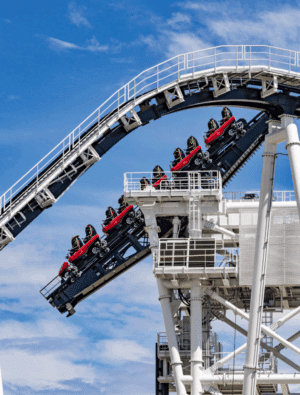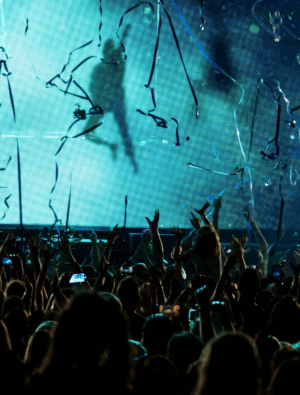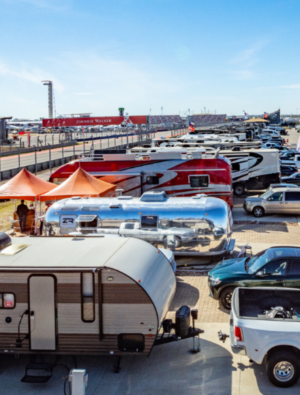We use cookies and similar technologies to help personalize content, tailor and measure ads, and provide a better experience. By clicking accept, you agree to this, as outlined in our Privacy Policy.
Texas Formula 1: How I Showed My Dad the Stories He’d Told Me


In 1984, Formula 1 racing came to Dallas – for the first and, at least until now, the last time. The event was big news for the racing world and a sensation for Dallas – then the subject of the wildly popular television show that bore the same name. For my dad and I, the 1984 Dallas Grand Prix left a lasting impression. Our memories differ but the impression that it left steered us both onto a course of profound appreciation for racing and ultimately… a journey to The Circuit of The Americas in Austin, some twenty-eight years later. This is our story and these are our recollections.
Chris:
There are a couple of things that I remember vividly about Dallas circa 1984. One: corporal punishment was still alive and well in the public school system. My butt caught the business end of the principal’s paddle for instigating a food fight at Lipscomb Elementary School. Two: Formula 1 came to town. My recollections of the race (as well as the paddling for that matter) have likely been mutated and distorted through the lens of my then seven year old imagination, but it made an impression on me, one that has informed and enriched my life in some way or another for the past 30 years.
Tupper:
In 1984 I was a 34 year old general assignment reporter for the Dallas Times Herald with no expertise or experience covering motorsports events. For inexplicable reasons, I was assigned to cover the 1984 Dallas Grand Prix from a civic/business point of view.
I have no idea why I received the assignment — probably because I wandered by the City Editor right when he was looking for an available reporter. But the assignment ignited a passion for the sport that burns today in an avid Formula 1 fan and a dedicated SCCA club racer.
Chris:
I remember hearing the cars…everywhere! From what I recall, the whole city rang with the song of our exotic visitors. Parks, schools, alleys and our backyard were all within audible range of the cars. I fell asleep to them every night for a week. I remember there was race residual and regalia everywhere as well. Banners promoting the race lined every street and it seemed like every mall, grocery store and lobby had a Formula 1 display car prominently and majestically poised.
Tupper:
As a general assignment reporter, I wasn’t expected to cover the sporting aspects of the race. That was left to the Sports Desk — or the Toy Department as we called it. I was free to cover the spectacle of the event — and what a spectacle it was.
It seemed the city was obsessed with Formula 1 as the July 8 event grew near. We could hear the screaming whine of the cars practicing from the home my wife and I shared with our three young children — the oldest who was just seven at the time.
It was a classic Texas Big Event, promoted by a pair of big spending Dallas businessmen, that captivated the city’s imagination and brought the city a moment of global attention.
Chris:
I know the Grand Prix street course weaved through the Texas State Fairgrounds, constructed of existing roads and asphalt. I remember one night being loaded into the back of the Hull family hauler (a 1982 diesel Volkswagen Dasher wagon) and ripping through the course that was partially open to traffic and partially enclosed with sponsor-clad K-wall and chain link catch fence. Two baby sisters and I in the back and my dad in the drivers seat, floating the Dasher through four-wheeled drifts around the course, smoke billowing out from behind the ol’ wagon as we undoubtedly set course records. My sisters and I pin balling right and left across the bench seat as dad applied full opposite lock through the ragged curbed corners. Mountain ranges of bleacher seats whizzing by as we careened through the valley of speed. I’m 99% sure it happened like this, though my account conflicts slightly with other family member’s recollections.
Tupper:
By the time the 800 horsepower, four and six cylinder cars arrived, the graceful art deco buildings of the Texas State Fairgrounds — presided over by 55-foot-tall Big Tex — had been converted into a fast and impressive raceway. It wasn’t Monaco or Monza, but it was our brief moment of international cache. There were parties everywhere, at which the accents of the Old World and Old Money mingled and clashed with the accents of Oil Money and Big Business.
I recall vividly a party held at Southfork Ranch, the fictional home of the Ewing clan from the Dallas soap opera, where upon arrival we found one of the gorgeous Benetton cars parked in the circular driveway. (I also recall being shocked that the grand scale of the Ewing’s Southfork estate was, in reality, a rather modest suburban home surrounded by horse pastures.)
Back then, the teams were housed in a single large exhibit hall that functioned as the garage. There were few high-tech gadgets or slickly designed garage facades. Sweating mechanics used hack saw blades to cut holes in the cars’ shells in an effort to get a few more cubic inches of cooling air into those monster motors.
And Eddie Cheever, a darling of the Dallas media because he was the only American driver on the circuit, was gracious enough to allow a wide-eyed reporter to sit in the back seat of his rental car as he navigated the race course with his chief mechanic for the first time.
Chris:
I’m pretty sure at some point during the week, I met and carried on in conversation with Nigel Mansell, Niki Lauda, Ayrton Senna and Keke Rosberg. Though again, the account of the 7 year old… does not align with that of others.
The fact is, I wasn’t even in Dallas for the race weekend. I was in California, visiting cousins. I was scheduled to return home before race day, but I was enjoying my time in California. I remember a call with my dad where he proposed a tough decision that I had to make.
“Do you want to stay in California for another week… or do you want to come home to Dallas to see the race?”
I was seven… I did not weigh pros and cons well. I did not navigate delayed gratification well. I stayed in California. I missed the race.
Tupper:
As race day arrived, it was becoming increasingly apparent that holding a Formula One race in July in Dallas posed some major challenges.
The international jet set complained bitterly about the heat and humidity. The racing surface on the circuit began to deteriorate so badly during practice sessions that one hour before the race was scheduled to begin, organizers were dumping truck loads of ice on concrete patches hoping to hasten the curing process.
The clear plastic windows of the temporary luxury suites, cooled by huge portable air conditioners, became quickly fogged with condensation, requiring the removal of the windows that in turn exposed those pricey seats to the searing elements.
A group of drivers, led by Nicki Lauda, holed up in the drivers lounge and threatened to boycott the event.
And in the defining visual memory of the 1984 Dallas Grand Prix, Lotus’s Nigel Mansell collapsed on the blistering racing surface after attempting to push his disabled car across the finish line.
It was perhaps that determination — or that flair for the theatrical — that compelled Mansell to push beyond his body’s limits. Whatever it was, I knew at some level this was a special event and these were special competitors.
Chris:
Missing the race was something that I regretted, but eventually came to appreciate as bitter sweet. While I didn’t actually get to see any action, I am glad that my memory of the week lives on through my imagination more than actual events. The concoction of first hand experience, my dad’s stories and fantasy are what made me a race fan and planted a seed of motorsports fascination.
I was baptized in speed in the summer of 1984, when Formula 1 came to Dallas. Cars, bikes, and a lifelong investigation of horsepower have informed my life and steered many of my best experiences (and bad decisions).
My passion for racing eventually intersected with my career and in 2012 – when the hopes of Formula 1 returning to Texas became a reality – I was deeply embedded in the motorsports industry. I was fortunate enough to be working with a prominent brand in racing and through some strategic work/play negotiating, I was able to enjoy the first US Grand Prix at Circuit of The Americas with my dad. I pulled some strings and my dad and I got to bring our love for racing full circle, back to Texas where it all began for both of us.
Tupper:
All of these memories came flooding back to me when my son Chris — the wide-eyed seven-year-old in 1984 — and I joined the 118,000 fans who watched the inaugural US Grand Prix at Circuit of the Americas in 2012.
It was a treasured weekend at a brilliant track and an event nothing like the ill-fated spectacle of 1984. It was a rare opportunity for a father to spend quality time with a son, now a man, with whom he spends far too little time. And it was affirmation that Texas, and the United States, support and cherish the very best motorsports competition the world has to offer.
Today, the flame that was ignited in 1984 burns as brightly as ever. I’ve built, maintained and campaigned two of my own race cars — a couple of battered 1990 Spec Miatas — for the past 10 years. When he is able, Chris is always ready to drop what he’s doing to support his dad when we assemble a team for a 24-hour endurance event.
But returning to Texas for the inaugural U.S. Grand Prix in 2012 was one of those moments when I realize our roles in life had started to change. Chris was the organizer and the leader, who had access to the special places, who could recite the relevant team statistics and was on a first-name basis with some amazing people. It was a moment of incredible pride and of knowing the kid who drove me nuts for much of his young life, who managed to get himself paddled in school on a fairly regular basis, was now a man of enormous talent, creativity and respect.
Chris:
My dad and I have always had a great relationship and shared a variety of common interests. He’s inspired me in many ways and I hope that I’ve inspired him in some. Poignant conversations do not elude us and we can debate, relate, appreciate and annoy each other effortlessly, but we are different in many ways. Racing is one of the easiest things for us to talk about. It is a shared fascination that can force us to make our schedules align and remind us to pick up the phone.
When I was 7 years old, I fell in love with Formula 1, but I didn’t have Formula 1 heroes. My hero was the guy that told me the stories about the Formula 1 drivers. My memory of Formula 1 was incubated in those stories and initiated my adoration of the sport. Though I spent the next 30+ years of my life living in California, Formula 1 happened to me in Texas. Coming to Austin in 2012 and getting to experience the inaugural race at such a phenomenal facility was very special and very personal.
For five years, I spent many a weekend clad in a team uniform and paddock pass, granting me access to some of the most prestigious motorsports events around the globe. I’ve walked and worked the paddock on some of the most hallowed grounds of motorsports from Monza to Talladega, from The Nurburgring to Indianapolis. It can all be traced back to the summer of 1984, when Formula 1 came to Texas. But none of the experiences that I’ve had at a racetrack will live as indelibly and importantly to me as standing at the top of COTA turn one, while twenty Formula 1 cars elbowed their way up the hill, with my dad next to me.
Formula One returns to Texas October 23-25, 2015. Beauty, speed, excitement and memorable family bonding guaranteed. To experience the greatest spectacle in motorsports, with your kin, click here for tickets. Hurry tickets are going fast!


















